Major problems in pronouncing English: A case study at the University of Dalat
Seeing that pronunciation is one of the most important factors influencing learners’ speech
intelligibility, this study investigated the sounds performed by English-majoring students at the
University of Dalat. In an attempt to figure out main pronouncing errors as well as possible reasons for
the students’ problems, 210 English freshmen were chosen randomly to participate in the study. The
data collected from pronunciation tests and students’ recordings were analyzed descriptively with the
application of Wavesurfer software version 1.8.8p5, 2013. Based on the finding results, the study
highlighted four major pronunciation errors: the omission of final consonants, the mispronunciation of
consonant clusters, the substitution of certain sounds, and the mispronunciation of English vowels.
These errors were considered to originate from the learners’ lack of phonetic knowledge, the
incompatibleness between the two languages, and a negative transference to balance with Vietnamese
learners’ speech organs.
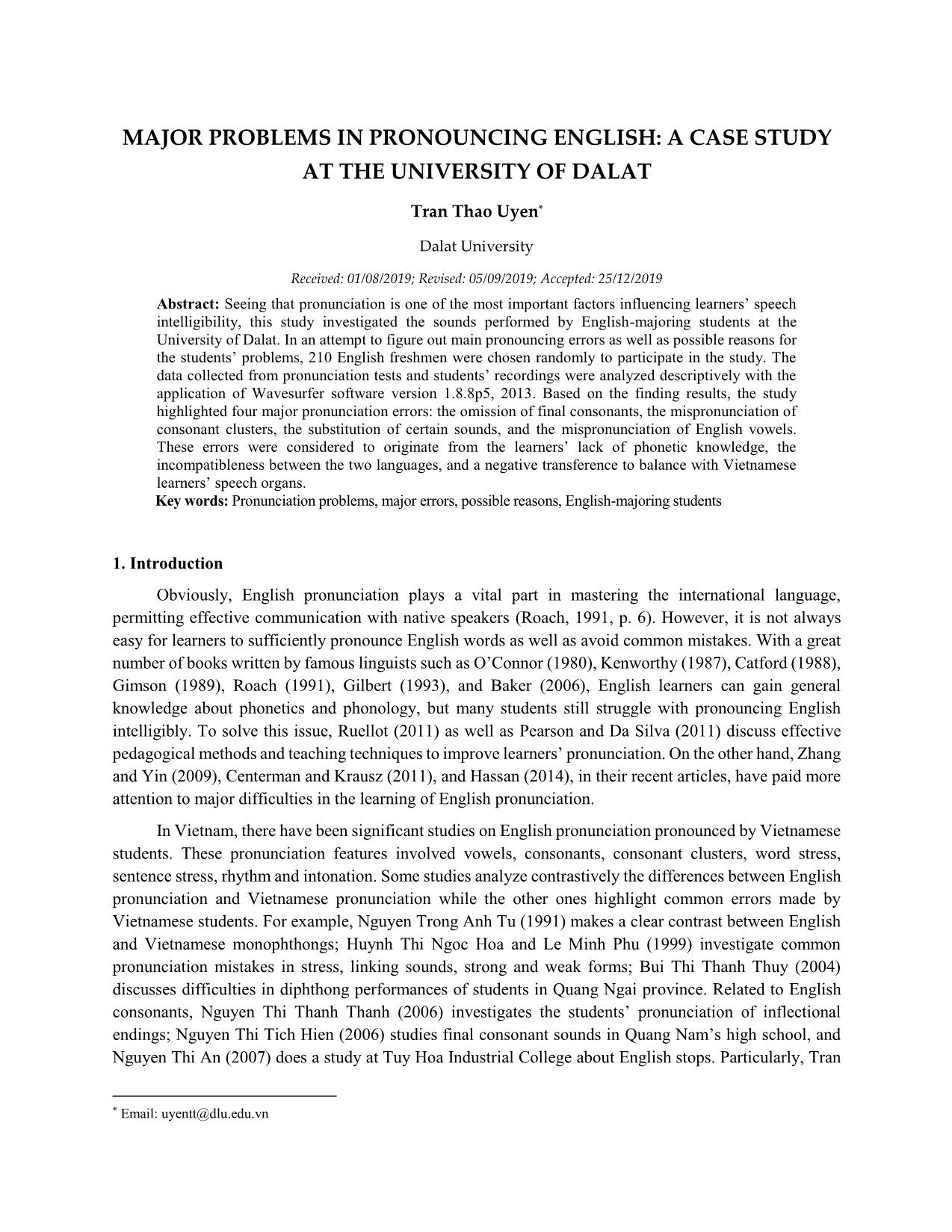
Trang 1
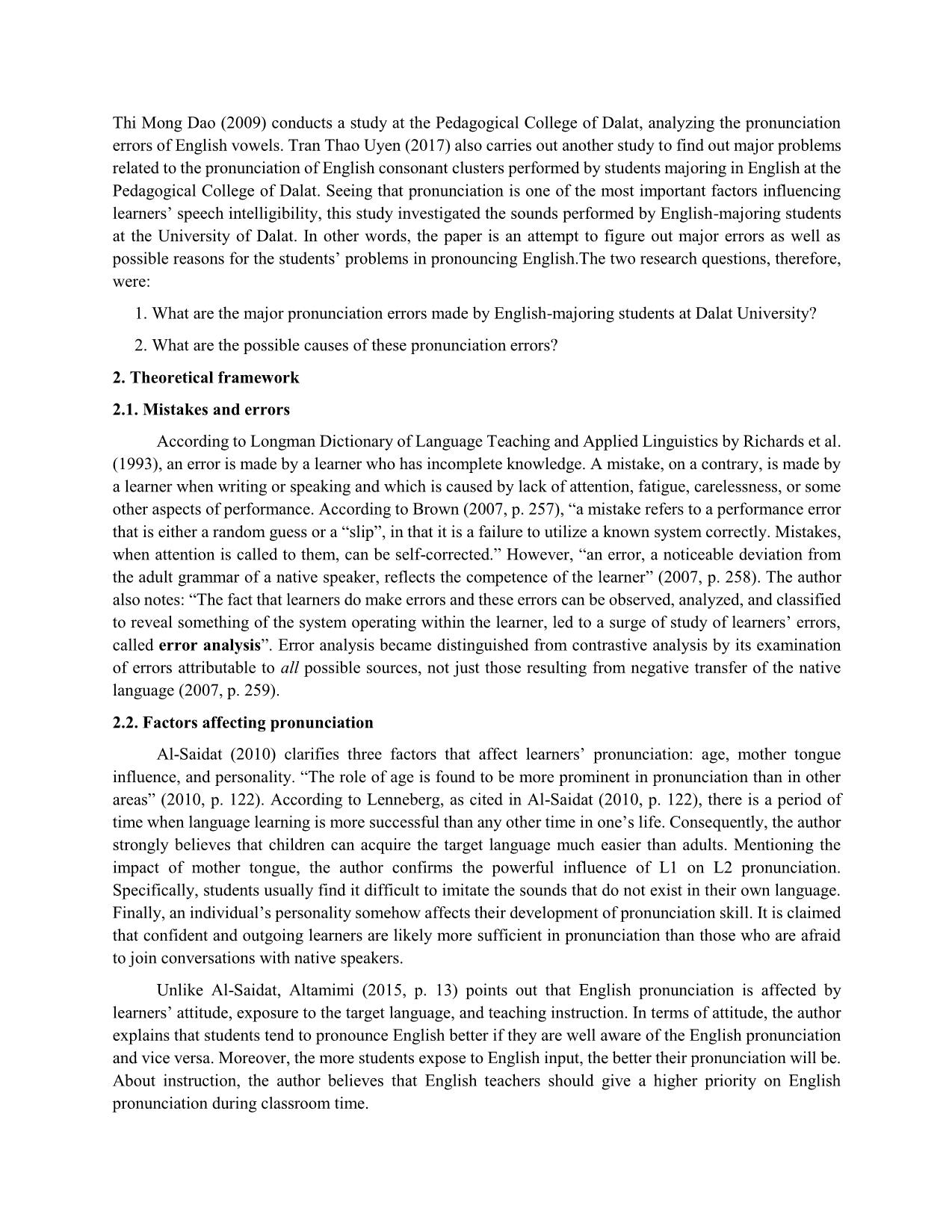
Trang 2
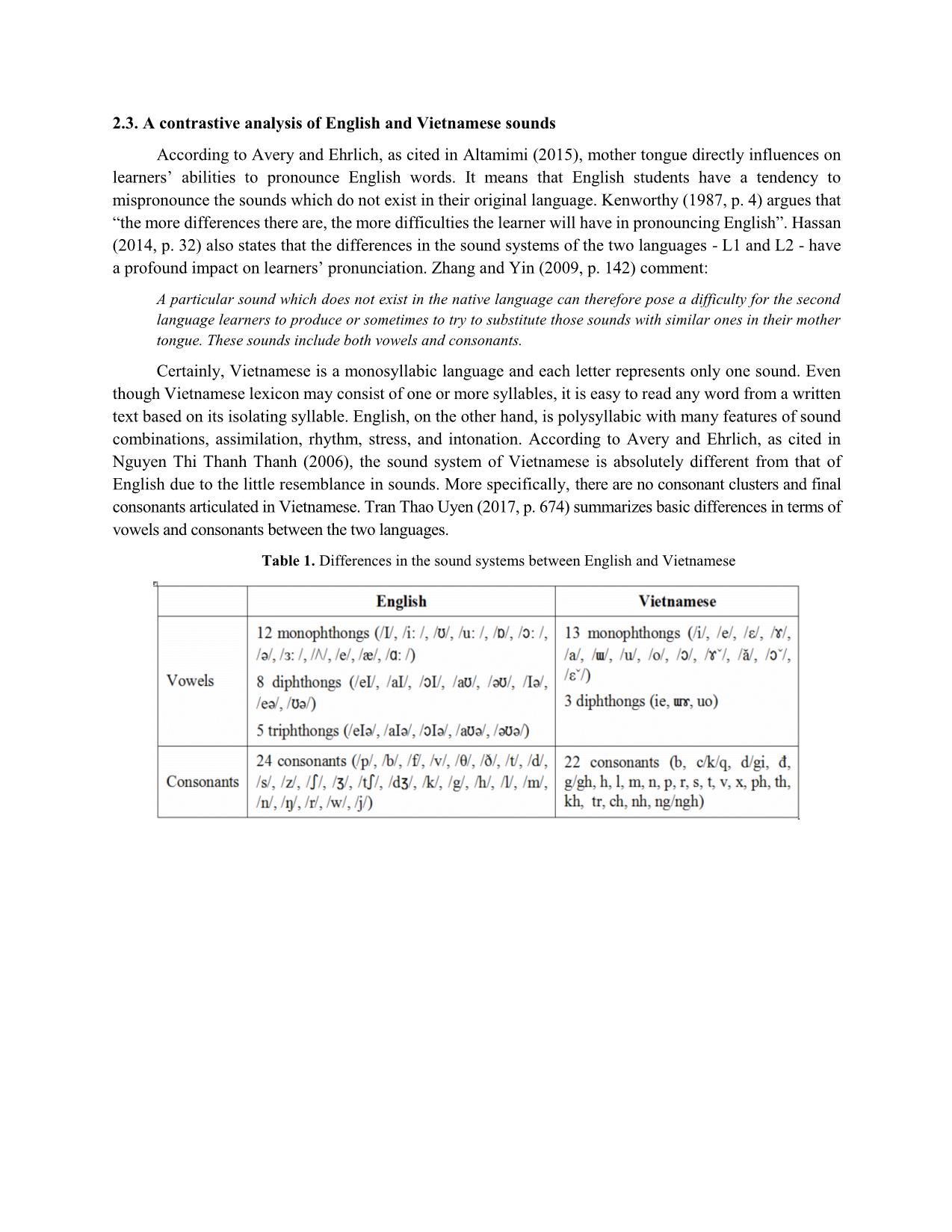
Trang 3
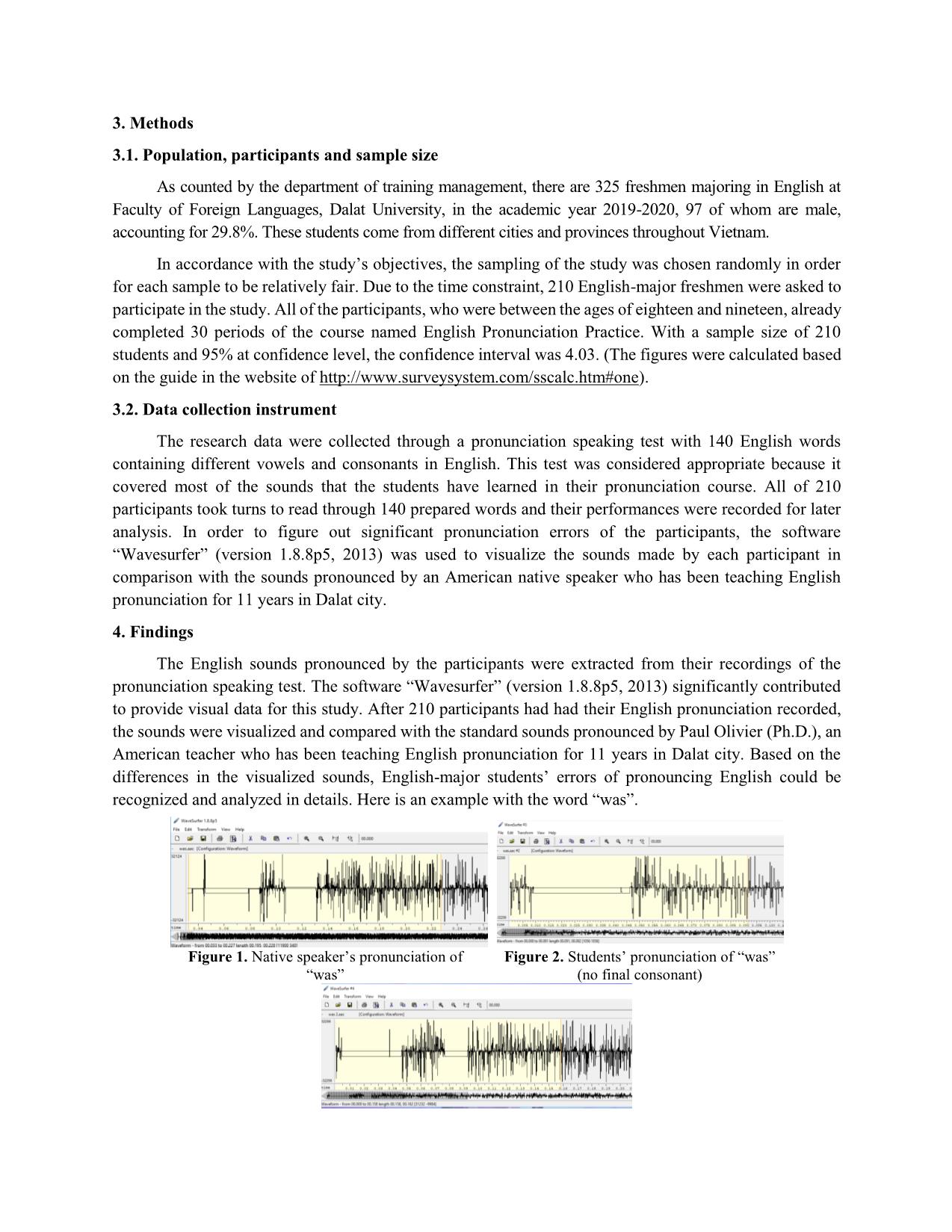
Trang 4
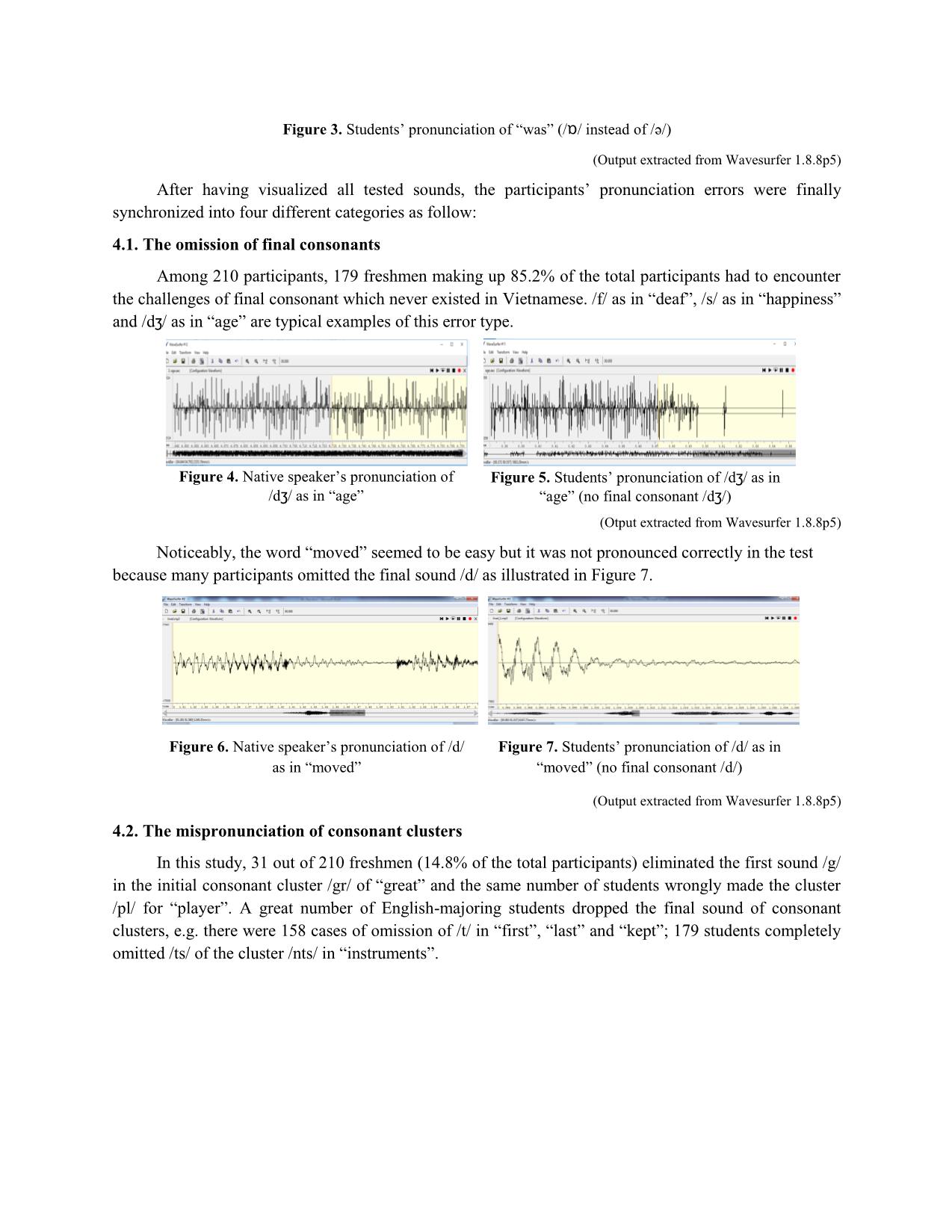
Trang 5
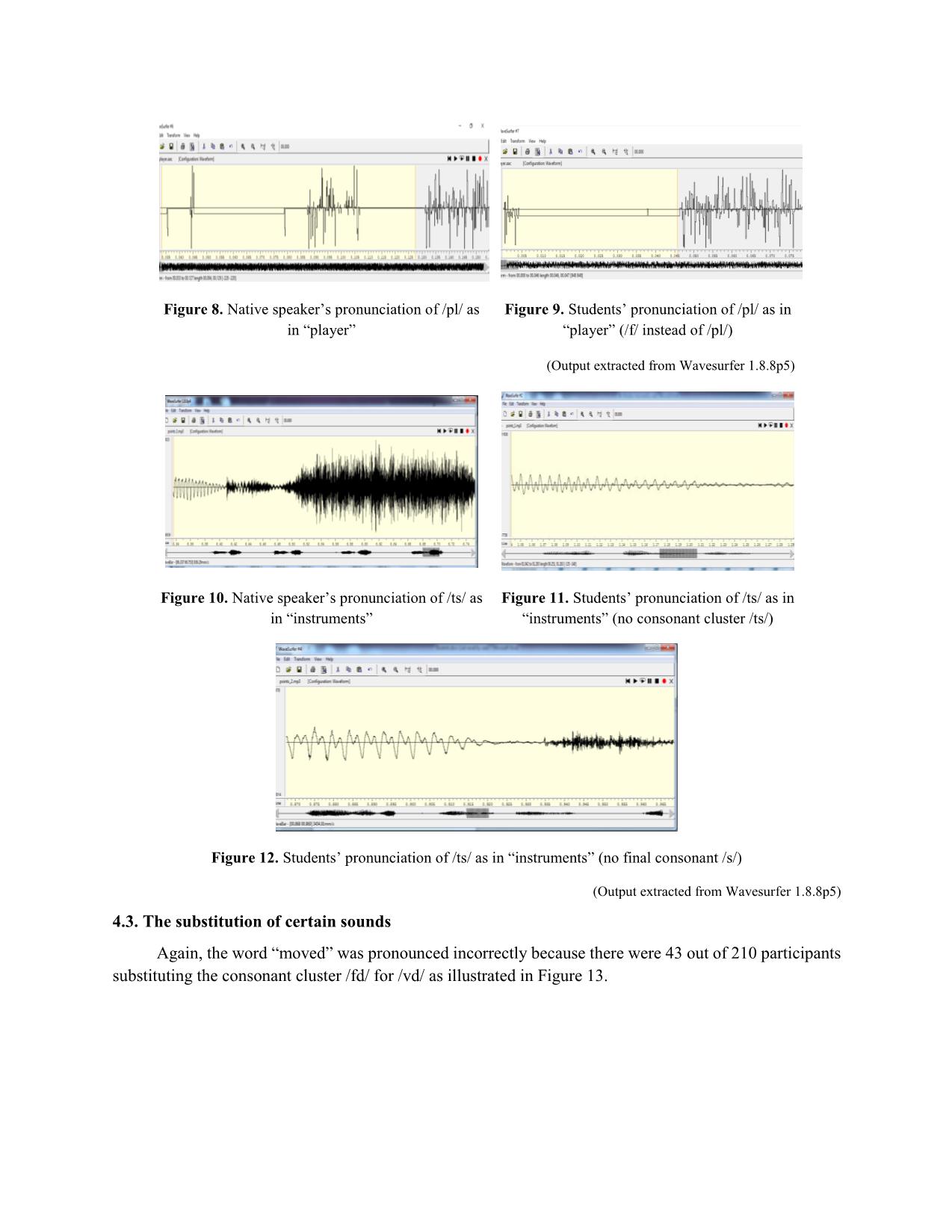
Trang 6
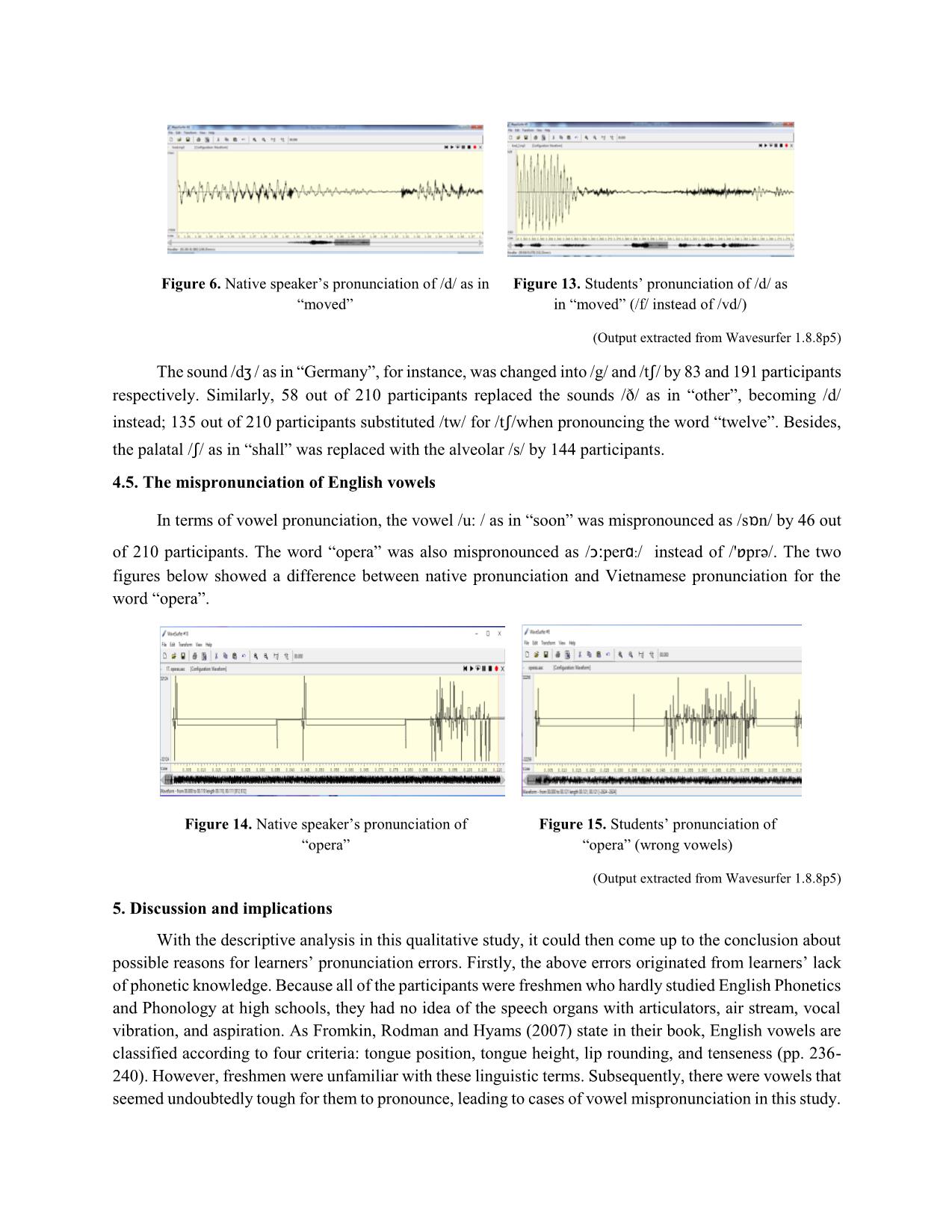
Trang 7
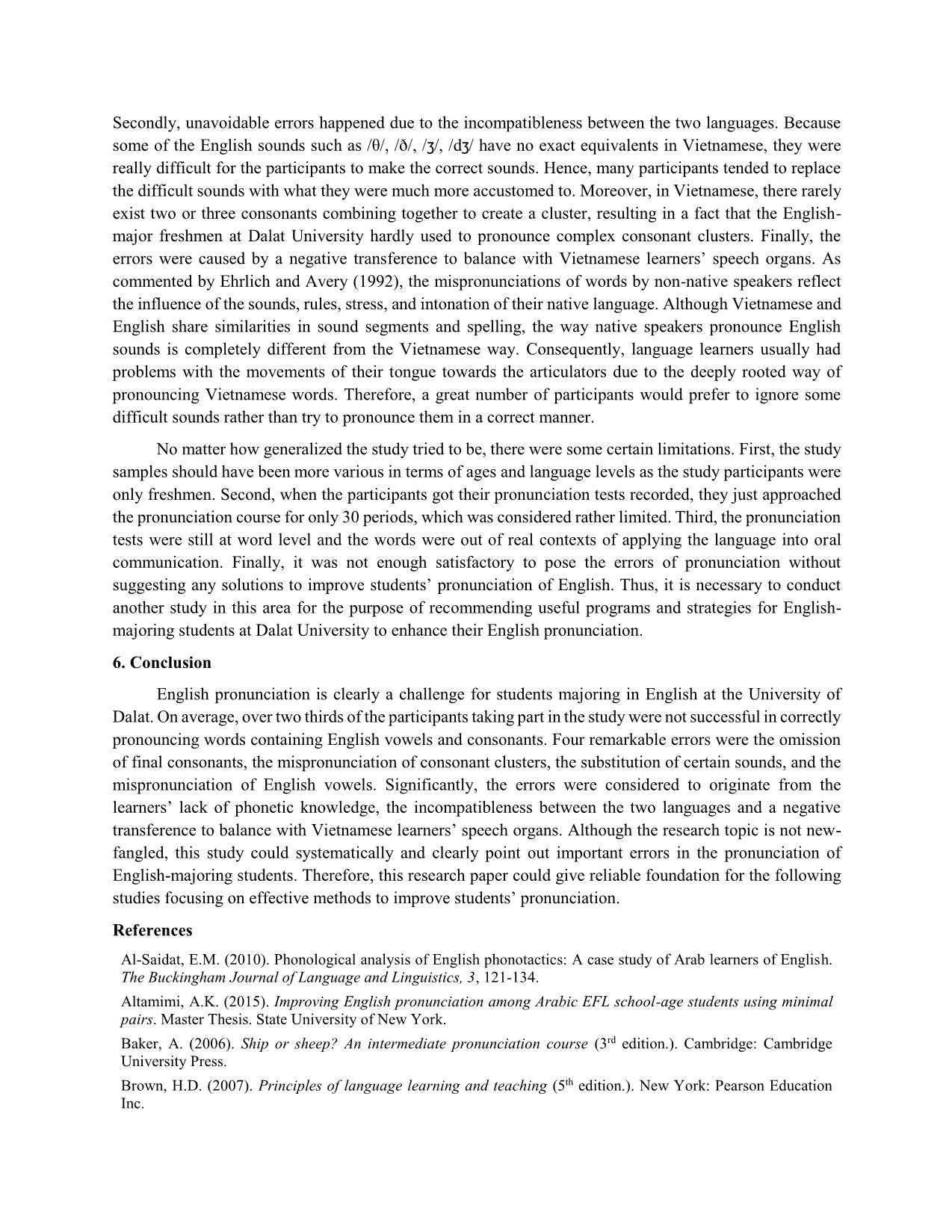
Trang 8
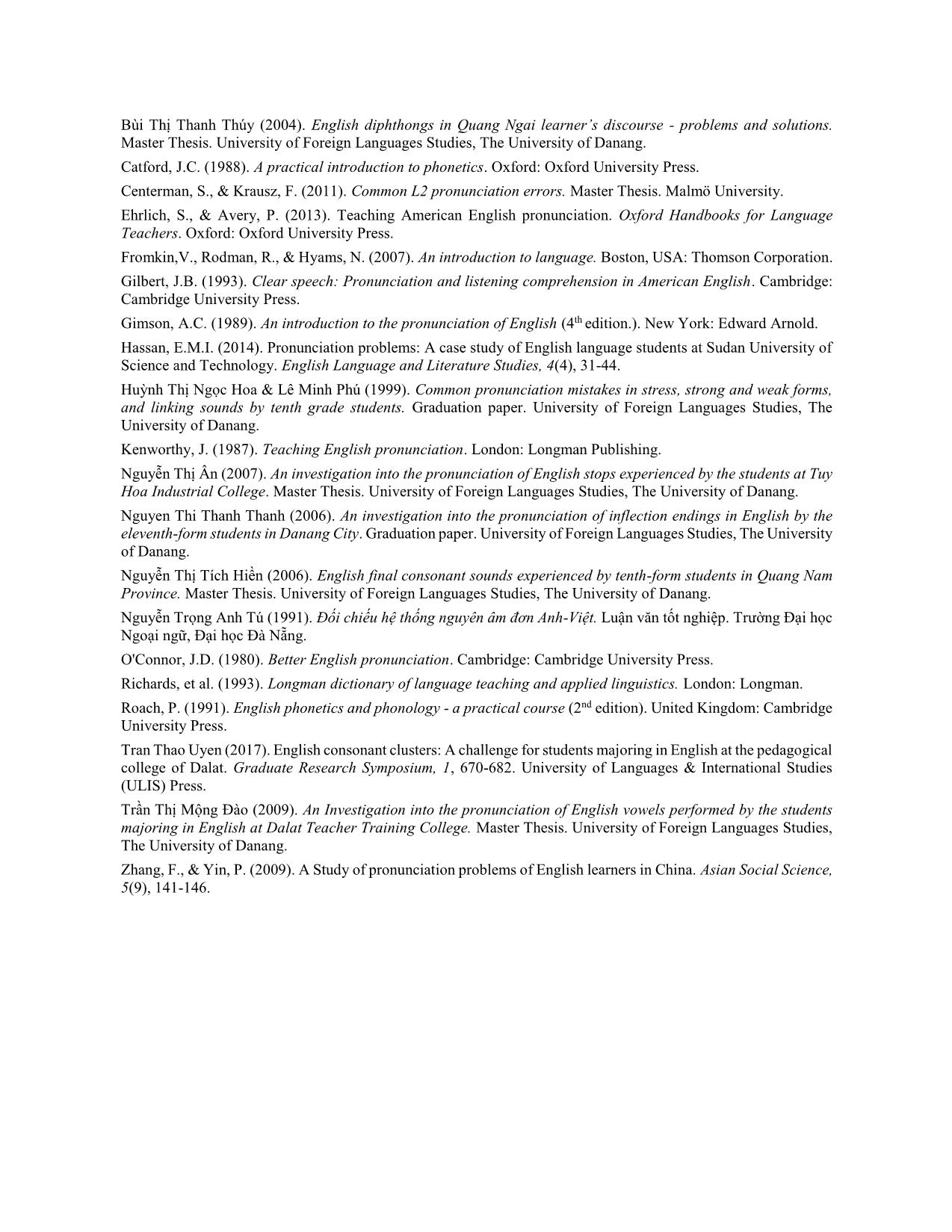
Trang 9

Trang 10
Tóm tắt nội dung tài liệu: Major problems in pronouncing English: A case study at the University of Dalat
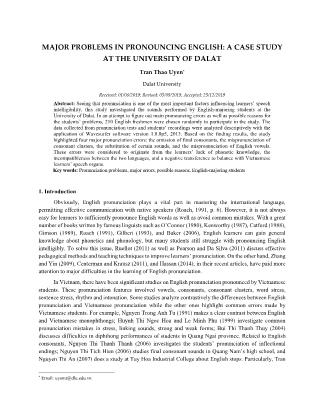
ives, the sampling of the study was chosen randomly in order for each sample to be relatively fair. Due to the time constraint, 210 English-major freshmen were asked to participate in the study. All of the participants, who were between the ages of eighteen and nineteen, already completed 30 periods of the course named English Pronunciation Practice. With a sample size of 210 students and 95% at confidence level, the confidence interval was 4.03. (The figures were calculated based on the guide in the website of 3.2. Data collection instrument The research data were collected through a pronunciation speaking test with 140 English words containing different vowels and consonants in English. This test was considered appropriate because it covered most of the sounds that the students have learned in their pronunciation course. All of 210 participants took turns to read through 140 prepared words and their performances were recorded for later analysis. In order to figure out significant pronunciation errors of the participants, the software “Wavesurfer” (version 1.8.8p5, 2013) was used to visualize the sounds made by each participant in comparison with the sounds pronounced by an American native speaker who has been teaching English pronunciation for 11 years in Dalat city. 4. Findings The English sounds pronounced by the participants were extracted from their recordings of the pronunciation speaking test. The software “Wavesurfer” (version 1.8.8p5, 2013) significantly contributed to provide visual data for this study. After 210 participants had had their English pronunciation recorded, the sounds were visualized and compared with the standard sounds pronounced by Paul Olivier (Ph.D.), an American teacher who has been teaching English pronunciation for 11 years in Dalat city. Based on the differences in the visualized sounds, English-major students’ errors of pronouncing English could be recognized and analyzed in details. Here is an example with the word “was”. Figure 1. Native speaker’s pronunciation of “was” Figure 2. Students’ pronunciation of “was” (no final consonant) Figure 3. Students’ pronunciation of “was” (/ɒ/ instead of /ə/) (Output extracted from Wavesurfer 1.8.8p5) After having visualized all tested sounds, the participants’ pronunciation errors were finally synchronized into four different categories as follow: 4.1. The omission of final consonants Among 210 participants, 179 freshmen making up 85.2% of the total participants had to encounter the challenges of final consonant which never existed in Vietnamese. /f/ as in “deaf”, /s/ as in “happiness” and /dʒ/ as in “age” are typical examples of this error type. Figure 4. Native speaker’s pronunciation of /dʒ/ as in “age” Figure 5. Students’ pronunciation of /dʒ/ as in “age” (no final consonant /dʒ/) (Otput extracted from Wavesurfer 1.8.8p5) Noticeably, the word “moved” seemed to be easy but it was not pronounced correctly in the test because many participants omitted the final sound /d/ as illustrated in Figure 7. Figure 6. Native speaker’s pronunciation of /d/ as in “moved” Figure 7. Students’ pronunciation of /d/ as in “moved” (no final consonant /d/) (Output extracted from Wavesurfer 1.8.8p5) 4.2. The mispronunciation of consonant clusters In this study, 31 out of 210 freshmen (14.8% of the total participants) eliminated the first sound /g/ in the initial consonant cluster /gr/ of “great” and the same number of students wrongly made the cluster /pl/ for “player”. A great number of English-majoring students dropped the final sound of consonant clusters, e.g. there were 158 cases of omission of /t/ in “first”, “last” and “kept”; 179 students completely omitted /ts/ of the cluster /nts/ in “instruments”. Figure 8. Native speaker’s pronunciation of /pl/ as in “player” Figure 9. Students’ pronunciation of /pl/ as in “player” (/f/ instead of /pl/) (Output extracted from Wavesurfer 1.8.8p5) Figure 10. Native speaker’s pronunciation of /ts/ as in “instruments” Figure 11. Students’ pronunciation of /ts/ as in “instruments” (no consonant cluster /ts/) Figure 12. Students’ pronunciation of /ts/ as in “instruments” (no final consonant /s/) (Output extracted from Wavesurfer 1.8.8p5) 4.3. The substitution of certain sounds Again, the word “moved” was pronounced incorrectly because there were 43 out of 210 participants substituting the consonant cluster /fd/ for /vd/ as illustrated in Figure 13. Figure 6. Native speaker’s pronunciation of /d/ as in “moved” Figure 13. Students’ pronunciation of /d/ as in “moved” (/f/ instead of /vd/) (Output extracted from Wavesurfer 1.8.8p5) The sound /dʒ / as in “Germany”, for instance, was changed into /g/ and /tʃ/ by 83 and 191 participants respectively. Similarly, 58 out of 210 participants replaced the sounds /ð/ as in “other”, becoming /d/ instead; 135 out of 210 participants substituted /tw/ for /tʃ/when pronouncing the word “twelve”. Besides, the palatal /ʃ/ as in “shall” was replaced with the alveolar /s/ by 144 participants. 4.5. The mispronunciation of English vowels In terms of vowel pronunciation, the vowel /u: / as in “soon” was mispronounced as /sɒn/ by 46 out of 210 participants. The word “opera” was also mispronounced as /ɔ:perɑ:/ instead of /'ɒprə/. The two figures below showed a difference between native pronunciation and Vietnamese pronunciation for the word “opera”. Figure 14. Native speaker’s pronunciation of “opera” Figure 15. Students’ pronunciation of “opera” (wrong vowels) (Output extracted from Wavesurfer 1.8.8p5) 5. Discussion and implications With the descriptive analysis in this qualitative study, it could then come up to the conclusion about possible reasons for learners’ pronunciation errors. Firstly, the above errors originated from learners’ lack of phonetic knowledge. Because all of the participants were freshmen who hardly studied English Phonetics and Phonology at high schools, they had no idea of the speech organs with articulators, air stream, vocal vibration, and aspiration. As Fromkin, Rodman and Hyams (2007) state in their book, English vowels are classified according to four criteria: tongue position, tongue height, lip rounding, and tenseness (pp. 236- 240). However, freshmen were unfamiliar with these linguistic terms. Subsequently, there were vowels that seemed undoubtedly tough for them to pronounce, leading to cases of vowel mispronunciation in this study. Secondly, unavoidable errors happened due to the incompatibleness between the two languages. Because some of the English sounds such as /θ/, /ð/, /ʒ/, /dʒ/ have no exact equivalents in Vietnamese, they were really difficult for the participants to make the correct sounds. Hence, many participants tended to replace the difficult sounds with what they were much more accustomed to. Moreover, in Vietnamese, there rarely exist two or three consonants combining together to create a cluster, resulting in a fact that the English- major freshmen at Dalat University hardly used to pronounce complex consonant clusters. Finally, the errors were caused by a negative transference to balance with Vietnamese learners’ speech organs. As commented by Ehrlich and Avery (1992), the mispronunciations of words by non-native speakers reflect the influence of the sounds, rules, stress, and intonation of their native language. Although Vietnamese and English share similarities in sound segments and spelling, the way native speakers pronounce English sounds is completely different from the Vietnamese way. Consequently, language learners usually had problems with the movements of their tongue towards the articulators due to the deeply rooted way of pronouncing Vietnamese words. Therefore, a great number of participants would prefer to ignore some difficult sounds rather than try to pronounce them in a correct manner. No matter how generalized the study tried to be, there were some certain limitations. First, the study samples should have been more various in terms of ages and language levels as the study participants were only freshmen. Second, when the participants got their pronunciation tests recorded, they just approached the pronunciation course for only 30 periods, which was considered rather limited. Third, the pronunciation tests were still at word level and the words were out of real contexts of applying the language into oral communication. Finally, it was not enough satisfactory to pose the errors of pronunciation without suggesting any solutions to improve students’ pronunciation of English. Thus, it is necessary to conduct another study in this area for the purpose of recommending useful programs and strategies for English- majoring students at Dalat University to enhance their English pronunciation. 6. Conclusion English pronunciation is clearly a challenge for students majoring in English at the University of Dalat. On average, over two thirds of the participants taking part in the study were not successful in correctly pronouncing words containing English vowels and consonants. Four remarkable errors were the omission of final consonants, the mispronunciation of consonant clusters, the substitution of certain sounds, and the mispronunciation of English vowels. Significantly, the errors were considered to originate from the learners’ lack of phonetic knowledge, the incompatibleness between the two languages and a negative transference to balance with Vietnamese learners’ speech organs. Although the research topic is not new- fangled, this study could systematically and clearly point out important errors in the pronunciation of English-majoring students. Therefore, this research paper could give reliable foundation for the following studies focusing on effective methods to improve students’ pronunciation. References Al-Saidat, E.M. (2010). Phonological analysis of English phonotactics: A case study of Arab learners of English. The Buckingham Journal of Language and Linguistics, 3, 121-134. Altamimi, A.K. (2015). Improving English pronunciation among Arabic EFL school-age students using minimal pairs. Master Thesis. State University of New York. Baker, A. (2006). Ship or sheep? An intermediate pronunciation course (3rd edition.). Cambridge: Cambridge University Press. Brown, H.D. (2007). Principles of language learning and teaching (5th edition.). New York: Pearson Education Inc. Bùi Thị Thanh Thúy (2004). English diphthongs in Quang Ngai learner’s discourse - problems and solutions. Master Thesis. University of Foreign Languages Studies, The University of Danang. Catford, J.C. (1988). A practical introduction to phonetics. Oxford: Oxford University Press. Centerman, S., & Krausz, F. (2011). Common L2 pronunciation errors. Master Thesis. Malmö University. Ehrlich, S., & Avery, P. (2013). Teaching American English pronunciation. Oxford Handbooks for Language Teachers. Oxford: Oxford University Press. Fromkin,V., Rodman, R., & Hyams, N. (2007). An introduction to language. Boston, USA: Thomson Corporation. Gilbert, J.B. (1993). Clear speech: Pronunciation and listening comprehension in American English. Cambridge: Cambridge University Press. Gimson, A.C. (1989). An introduction to the pronunciation of English (4th edition.). New York: Edward Arnold. Hassan, E.M.I. (2014). Pronunciation problems: A case study of English language students at Sudan University of Science and Technology. English Language and Literature Studies, 4(4), 31-44. Huỳnh Thị Ngọc Hoa & Lê Minh Phú (1999). Common pronunciation mistakes in stress, strong and weak forms, and linking sounds by tenth grade students. Graduation paper. University of Foreign Languages Studies, The University of Danang. Kenworthy, J. (1987). Teaching English pronunciation. London: Longman Publishing. Nguyễn Thị Ân (2007). An investigation into the pronunciation of English stops experienced by the students at Tuy Hoa Industrial College. Master Thesis. University of Foreign Languages Studies, The University of Danang. Nguyen Thi Thanh Thanh (2006). An investigation into the pronunciation of inflection endings in English by the eleventh-form students in Danang City. Graduation paper. University of Foreign Languages Studies, The University of Danang. Nguyễn Thị Tích Hiền (2006). English final consonant sounds experienced by tenth-form students in Quang Nam Province. Master Thesis. University of Foreign Languages Studies, The University of Danang. Nguyễn Trọng Anh Tú (1991). Đối chiếu hệ thống nguyên âm đơn Anh-Việt. Luận văn tốt nghiệp. Trường Đại học Ngoại ngữ, Đại học Đà Nẵng. O'Connor, J.D. (1980). Better English pronunciation. Cambridge: Cambridge University Press. Richards, et al. (1993). Longman dictionary of language teaching and applied linguistics. London: Longman. Roach, P. (1991). English phonetics and phonology - a practical course (2nd edition). United Kingdom: Cambridge University Press. Tran Thao Uyen (2017). English consonant clusters: A challenge for students majoring in English at the pedagogical college of Dalat. Graduate Research Symposium, 1, 670-682. University of Languages & International Studies (ULIS) Press. Trần Thị Mộng Đào (2009). An Investigation into the pronunciation of English vowels performed by the students majoring in English at Dalat Teacher Training College. Master Thesis. University of Foreign Languages Studies, The University of Danang. Zhang, F., & Yin, P. (2009). A Study of pronunciation problems of English learners in China. Asian Social Science, 5(9), 141-146. NHỮNG VẤN ĐỀ NGHIÊM TRỌNG TRONG PHÁT ÂM TIẾNG ANH: NGHIÊN CỨU THỰC TẾ TẠI TRƯỜNG ĐẠI HỌC ĐÀ LẠT Tóm tắt: Nhận thức được rằng ngữ âm chính là một trong những yếu tố quan trọng ảnh hưởng đến khả năng giao tiếp của người học, nghiên cứu này tập trung phân tích các lỗi phát âm của sinh viên Ngôn ngữ Anh và tìm ra các lý do có thể khiến sinh viên phát âm sai. Khách thể nghiên cứu là 210 sinh viên chuyên ngành tiếng Anh năm thứ nhất tại Trường Đại học Đà Lạt. Dữ liệu được thu thập từ các bài kiểm tra ngữ âm và bản ghi âm giọng đọc của sinh viên được phân tích và mô tả với phần mềm Wavesurfer. Kết quả nghiên cứu cho thấy bốn lỗi phát âm cơ bản của sinh viên là không phát âm các phụ âm cuối, phát âm sai các cụm phụ âm, thay thế một số âm bằng những âm không chính xác và phát âm sai các nguyên âm. Những lỗi sai kể trên một phần là do người học thiếu kiến thức về ngữ âm tiếng Anh, một phần là do sự không tương thích về hệ thống âm thanh giữa hai ngôn ngữ và một phần là do ảnh hưởng của phương thức cấu tạo từ trong tiếng Việt đã tác động đến cách phát âm tiếng Anh. Từ khóa: Vấn đề về ngữ âm, sinh viên chuyên ngành tiếng Anh, lỗi phát âm sai
File đính kèm:
 major_problems_in_pronouncing_english_a_case_study_at_the_un.pdf
major_problems_in_pronouncing_english_a_case_study_at_the_un.pdf

